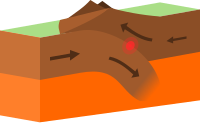
Photo from wikipedia
Abstract The Tethyan tectonic belt in western Yunnan, SW China, has witnessed a complex, multistage Tethyan evolution since the Paleozoic, including a late stage of continental collision between the Indian… Click to show full abstract
Abstract The Tethyan tectonic belt in western Yunnan, SW China, has witnessed a complex, multistage Tethyan evolution since the Paleozoic, including a late stage of continental collision between the Indian and Eurasian plates in the Cenozoic. Consequently, this belt has become a collage of Gondwana-derived microcontinental blocks and arc terranes wedged between two continents, including the Tengchong block, Baoshan block, Lincang block, and Simao block from west to east. To better understand the structure of these ancient continental blocks and the dynamic mechanism of the Indian-Eurasian continental collision, we investigate the electrical resistivity structure of the crust and uppermost mantle in the region. Magnetotelluric data were collected along a NW-SE striking transect crossing multiple tectonic terranes and were then modeled with a 3-D approach. The final resistivity model shows conductors beneath the Tengchong volcanic area, which may represent magma chambers that feed the active volcanism in the area. The electrical structure between the Tengchong area and the Wanding fault consists of layer-like lower crustal conductors along the transect, which may indicate mechanically weak layers where the tectonic escape of the Tibetan Plateau may occur via lower crustal flow. The Lincang block shows higher resistivity characteristics than the surrounding crust and demonstrates a trend of eastwardly napping resistors onto the Simao block, making up a crustal boundary of high-resistivity and low-resistivity bodies. This observation suggests that the Changning-Menglian suture between the Baoshan block and the Lincang block may be the boundary between Gondwana and Cathaysia.
Journal Title: Journal of Asian Earth Sciences
Year Published: 2021
Link to full text (if available)
Share on Social Media: Sign Up to like & get
recommendations!